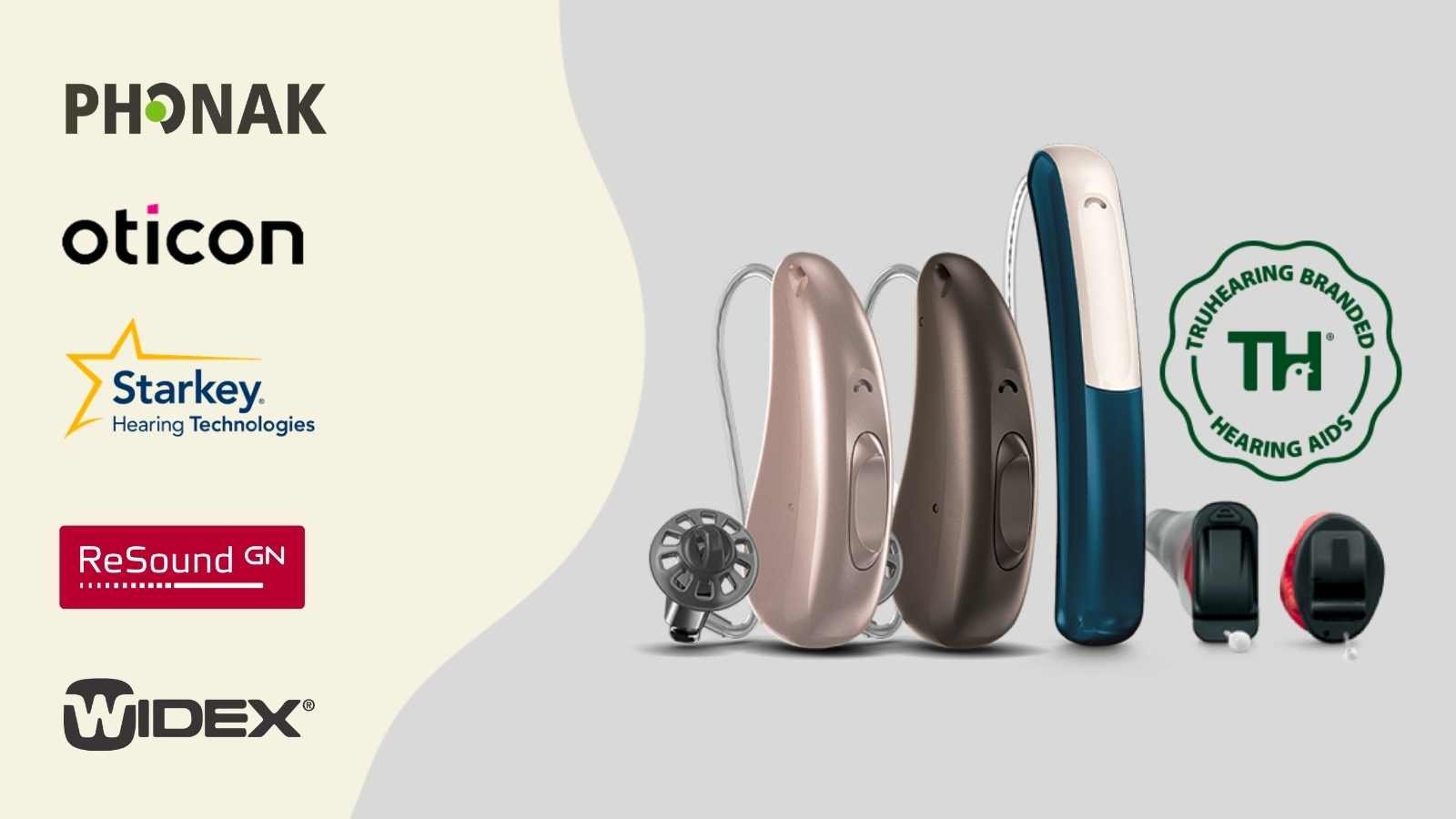Key Takeaways:
- There are many options today when it comes to hearing aids and hearing healthcare. TruHearing is one option that can provide lower cost options, or in some cases, no cost options (dependent on employer or health insurance benefits).
- TruHearing is a third-party managed care provider, and they offer hearing aids from the top six hearing aid manufacturers.
- It's essential to check with your health insurance provider to see what options you have for hearing healthcare and hearing aid benefit.

As an experienced audiologist, I've had the privilege of helping countless individuals navigate the complexities of hearing aid selection and health insurance benefits. It's a path that can often be confusing and overwhelming, particularly when it involves third-party programs like TruHearing. I understand the challenges — I've seen them firsthand. One of the key elements of my role involves not only diagnosing and treating hearing impairments, but also guiding patients through the process of understanding their best options, which sometimes includes utilizing programs like TruHearing. In this guide, we'll tell you everything you need to know about TruHearing— a leading provider of high-quality discount hearing aids.
What Is TruHearing?

TruHearing is a company that partners with major insurance providers to offer patients discounted hearing aids and services.
Founded in 2003, TruHearing set out to provide more affordable hearing healthcare options for those lacking hearing healthcare coverage as part of their insurance plan.
TruHearing is a third-party managed care provider and partners with over 85 healthcare plans, such as Blue Cross Blue Shield, Humana, VSP, and Health Alliance, among others.
The company is owned by hearing aid giant WS Audiology which also owns Widex, Signia, and HearUSA.
TrueHearing does not sell hearing aids directly on its website, instead, they send patients to its vast network of 6,000+ local clinics.
TruHearing patients who visit those clinics can take advantage of TruHearing prices but might also face some limitations.
Let's take a closer look.
How Does the TruHearing Process Work?

TruHearing partners with many health insurance providers, unions, and employer groups. You'll want to find out whether your insurance plan or employer partners with TruHearing, as well as the pricing and what to expect.
To find out if you are covered by TruHearing:
- Call TruHearing to verify your benefits. If you are eligible for TruHearing benefits but are not yet registered in their system, TruHearing will ask you some questions over the phone to complete the enrollment process. Call 1-800-334-1807 to get started with the process. You'll want to have your health insurance card, social security number, and other personal information handy while on the phone.
- Schedule an appointment with a local audiologist or hearing care provider. TruHearing can either help you set this appointment up or let you know of a local clinic where you can call to schedule. The key here is working through TruHearing to secure a discounted rate.
- Get a hearing test and a hearing aid evaluation (HAE) appointment. In order to discuss your best options, the audiologist will need an audiogram within the last six months. If you have not had a recent hearing test, this will need to happen first. During your appointment, the audiologist will discuss treatment options to best address your hearing loss and communication needs.
- Purchase hearing aids. If you decide to purchase hearing aids, payment will be processed for the order through TruHearing. TruHearing requires payment through their online portal or over the phone before your hearing aids can be ordered from the manufacturer. Your hearing professional will take the lead on this process during your appointment. After processing the payment, your local provider will schedule a hearing aid fitting appointment.
How Much Can I Expect to Pay?
When it comes to TruHearing's hearing aid benefits and pricing, it depends on your insurance provider, union group, or employer group.
Some plans may fully cover the cost of the hearing aids with no out-of-pocket expense for lower-level hearing aid technology, while others may only offer a select few hearing aid models with a higher price tag.
Several follow-up visits may also be covered in the first year but incur a service fee for future visits. The warranty for most hearing aids through TruHearing is three years. Be sure to verify your TruHearing benefits as well as clarify your expected costs. Contact TruHearing to find out more about your specific situation.
TruHearing claims on their website that the average customer saves $3,400 compared to retail.
Which brands does TruHearing carry?

The technology covered by your TruHearing plan may vary.
Some plans, such as TruHearing Select, will offer several leading hearing aid brands, including GN Resound, Starkey, Oticon, and Phonak.
Other plans, such as TruHearing Choice, will offer Signia hearing aids, one of the hearing aids made by the WS Audiology group, rebranded as TruHearing.
Once you have selected a hearing aid brand, you will also need to choose a technology level.
Typically, the higher the technology level, the greater the OOP cost. Here is a breakdown of technology levels and corresponding benefits. Note that for less expensive TruHearing branded devices, only two technology options are available: advanced and premium.
Essential (Called Mid at TruHearing)
This level of technology can offer basic audibility. It works especially well for those with a quiet lifestyle needing hearing aids on a more limited budget.
Standard (Called Mid-High at TruHearing)
Are you looking for hearing aids with a few more programs? This level of technology will offer a bit more customization than the essential level.
Advanced (Called Advanced at TruHearing)
Do you need a hearing aid that can also help in occasional background noise? Advanced is likely a good option.
Premium (Called Flagship at TruHearing)
This level of technology, offers support in background noise, wind noise reduction, and other useful features to provide maximum assistance in various dynamic listening situations.
Most manufacturers offer both rechargeable and battery-powered options. For hearing aids that use disposable batteries, TruHearing includes batteries as part of their offering when purchasing hearing aids.
TruHearing Pros and Cons

TruHearing can offer great affordable prices on high-quality hearing aids, depending on your healthcare plan. However, not all plans with TruHearing are the same. It's important to get all the information about your plan to make the right decision for your needs.
Pros:
· Options for treatment of mild to profound hearing loss.
· Wide selection of hearing aid brands and styles, although plan dependent.
· Several different technology levels to choose from.
· 60-day return policy, 3-year warranty, loss and damage policy, and one year of follow-up visits included.
Cons:
· More restricted plans may only offer one or two hearing aid brands.
· TruHearing does not partner with all insurance providers.
· Depending on your plan, other options like OTC hearing aids or discount services like ZipHearing may be more affordable.
TruHearing Return Policies and Follow-up Care

TruHearing has a 60-day return policy, so you can try out your hearing aid(s) with enough time to determine adequate benefit.
You'll want to follow up with your hearing care provider at least once before the end of your trial period.
TruHearing also offers a loss and damage policy, which will vary depending on your plan.
With this policy, you can replace lost or damaged hearing aids one time over the three-year period for a co-pay.
As mentioned previously, your co-pay will vary depending on your plan.
Check with TruHearing or your audiologist regarding how much you can expect to pay if you need to use your loss and damage co-pay.
What Do TruHearing Customers Say?
Many customers find that TruHearing provides them with hearing care options that they may be otherwise unable to afford.
Especially for those who have TruHearing benefits through a union, such as General Motors, TruHearing is likely their most affordable option for hearing care.
TruHearing provides a variety of hearing aid options, including BTE, RIC, ITE, and even CROS hearing aids.
For customers who prefer a particular hearing aid brand, TruHearing may not offer what they prefer. For example, a customer who has always worn Resound hearing aids but can only purchase a new pair of TruHearing/Signia hearing aids with their TruHearing Choice benefits may be happiest if they choose another care option.
It is important to note that you may incur additional service costs if you need a lot of follow-up care, such as frequent hearing aid cleanings or multiple fine-tuning appointments.
In this case, a bundled hearing aid model from a local audiology clinic may be a better long-term option.
Final Thoughts
If you're in the market for a new hearing aid, TruHearing is worth checking out.
With their wide selection of brands and styles, 60-day return policy, and commitment to customer service, there are certainly some advantages to getting your hearing aids through TruHearing.
Their partnership with major insurance providers means you could save big on your purchase.
You might also enjoy our affordable hearing aid guide here.

.jpg)




